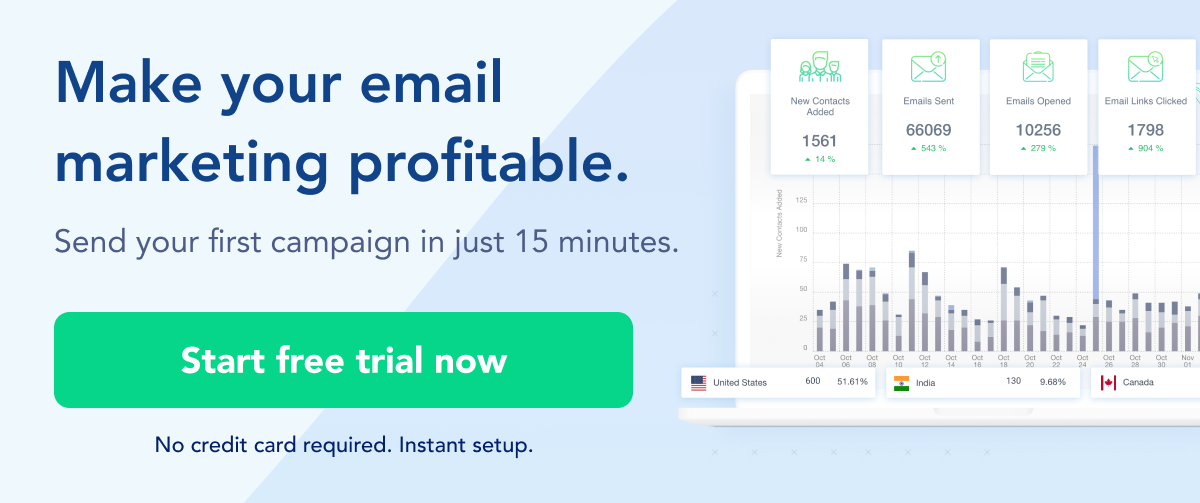
Crafting Irresistible Subject Lines with A/B Testing
Your subscribers have an inbox crammed with your competition and you have about 0.5 seconds to stand out.
That sounds as tricky as trying to make a cat take a bath!
We've got a secret weapon for you, and it’s not just about being clever or catchy. It’s about being smart — A/B testing your subject lines to understand what your audience really likes to see from your brand.
Table of Contents
Why Subject lines matter?
Think of your inbox like a mailbox stuffed with letters. Now, you're not going to open every single one, right? You're going to pick the ones that catch your eye because they seem interesting, important, or fun. That's what a subject line is for your email—it's the headline on the envelope that gets your email noticed.
We're all busy, zipping through our inboxes, often on our phones, just looking for reasons to hit delete and clear the clutter. Your subject line is the make-or-break moment where your email either jumps out and says "Hey, I'm worth your time!" or just whispers "Meh, you can skip me." It's your first, and sometimes only, shot to grab attention.
Why do they matter so much?
Because if your subject line is clear, catchy, and gives a hint that there's something worthwhile inside, people are way more likely to open it. And an opened email is the first step to whatever you want to happen next—whether that's reading an awesome article, snagging a sweet deal, or signing up for an event.
What is A/B testing?
A/B testing, also known as split testing, is a method where you compare two versions of something to see which one performs better. In the context of email subject lines, it means you create two different subject lines (A and B) for the same email. You send each version to a small, random segment of your email list and analyze which one has a higher open rate. The one that performs better (i.e., gets more opens) is then used for the rest of your email list.
- Example: Suppose you have an email list of 1000 people. You create two subject lines:
- Subject Line A: "Unlock Our Secret Tips for Success!"
- Subject Line B: "Exclusive Success Strategies Inside!"
You send each version to 100 people. If Subject Line A gets 30 opens and Subject Line B gets 50 opens, you would use Subject Line B for the remaining 800 people on your list.
Why should you A/B test your subject lines?
A/B testing your email subject lines is all about swapping guesswork for knowledge. Think about it—without testing, you're kind of like a chef tossing in spices without tasting the soup. You might have a hunch about what could work based on experience or intuition, but hunches don't always hit the mark.
With A/B testing, Instead of sending emails based on what you think will work, you send out two different subject lines to a small group of people. Then, you sit back and let the numbers do the talking. These aren't just any numbers; they're real reactions from your actual audience—not assumptions, not hunches, but solid data.
Here's the cool part: those numbers tell you a story. They tell you if your subscribers are more into catchy and creative or if they like it straight-up and no-nonsense. This isn't just useful for one email; it's gold for every email you'll send in the future. You'll start to see patterns, understand preferences, and get to know your audience better than ever.
So, why A/B test?
Because when you replace guesses with real, live data, you're not just hoping to connect—you're actually doing it. It's a smarter, savvier way to email, and it can totally transform your email marketing from hit-or-miss to hit-after-hit. That's why A/B testing isn't just something nice to do; it's a must-do if you want to get real about getting results.
Example of brands using A/B testing in subject lines
Let's look at the subject lines of Morning Brew emails. By sending out two different subject lines on the same day, they are presumably testing to see which one garners more opens, engagement, or click-throughs from their subscriber list.
Here's what you can takeaway from this strategy:
- Variation in Tone: Notice the variation in tone between subject lines—some are direct, while others might use humor or intrigue. This could be a test to see which tone resonates more with their audience.
- Subject Line Content: The content of the subject lines varies from teasers ("I have an announcement...") to more direct informational snippets ("New era - Google makes its next big AI move..."). This helps Morning Brew determine if their readers prefer mystery that incites curiosity or straight-to-the-point information.
- Consistency in Branding: Regardless of the subject line used, the brand ensures that their name "Morning Brew" is consistently present, maintaining brand awareness and trust.
Side Note: It's worth noting that the A/B testing observed in the screenshot wasn't conducted on the same email address. Instead, we used variations of the email addresses, one being the primary and the other a variation using a '+test' (e.g., originaladdress@gmail.com and originaladdress+test@gmail.com)
Subject line A/B testing ideas
Long Form vs Short Form: Test a succinct, to-the-point subject line against a longer, more descriptive one. For instance:
- A: "Sale Ends Tonight!"
- B: "Hurry! Your Last Chance to Grab Discounts on Our Exclusive Collection Ends Tonight!"
Clever vs Clear: Compare a witty, playful subject line with a straightforward, clear one. For example:
- A: "We're Spilling the Beans..."
- B: "New Coffee Flavors Available Now!"
Personalization vs General: Check the effectiveness of using the recipient's name or other personal details against a more generic approach. For instance:
- A: "Mike, A Special Gift Just for You!"
- B: "Exclusive Gifts for Our Valued Customers!"
Question vs Statement: Test whether asking a question is more engaging than making a statement. For example:
- A: "Ready to Transform Your Garden?"
- B: "Discover Our New Gardening Tools and Transform Your Space!"
Urgency vs Informative: Compare a subject line that creates a sense of urgency with one that is more informative. For instance:
- A: "Last Day to Claim Your Discount!"
- B: "Enjoy Our Range of Discounted Products Available This Week"
Direct Benefit vs. Curiosity Gap: This A/B test pits a subject line that clearly outlines the benefits against one that teases the content to invoke curiosity.
- Direct Benefit Example: "Save 20% on Your Next Order with Us!"
- Curiosity Gap Example: "You'll Never Guess What's Inside Your Discount..."
Local vs. Global Appeal: The idea is to compare the effectiveness of subject lines targeting a specific locale versus those intended for a wider audience.
- Local Appeal Example: "Chicago Foodies: Exclusive Deep-Dish Pizza Offers Inside!"
- Global Appeal Example: "Discover Our Exclusive Offers on Gourmet Pizzas!"
Emojis vs. No Emojis: This tests whether including emojis in your subject line makes it more appealing and increases the open rate compared to a subject line without emojis.
- Emojis Example: "🌟 Unlock Our Star Deals of the Week!"
- No Emojis Example: "Unlock Our Star Deals of the Week!"
Each of these tests can provide valuable insights into what triggers your audience to open an email. It's crucial to measure the open rates for each version and use this data to refine your future email marketing strategies. Remember, what works for one audience may not work for another, so continuous testing and adaptation are key to successful email marketing.
Tools you can use to A/B test your subject lines
A/B testing your subject lines is crucial in the world of email marketing, and luckily, there are some great tools out there to help you do just that. One of the standout options is — SendX.
SendX is an intuitive, feature-rich email marketing platform that’s designed to help marketers conduct effective A/B testing, especially with their subject lines. It’s all about taking the guesswork out of your campaigns and replacing it with data-driven decisions.
- Easy-to-Set-Up A/B Tests: SendX makes it a breeze to set up A/B tests. You can easily create two variants of your subject line for the same email and send them to different segments of your audience to see which performs better.
- Real-Time Analytics: After your emails are sent, SendX provides you with real-time analytics. You get to see which subject line is getting more opens and clicks, helping you understand what resonates with your audience.
- Automated Optimization: One of the coolest features? If you’re running a time-sensitive campaign, SendX can automatically determine the winning subject line after a certain period and send the rest of the emails with the more successful subject line. Talk about smart!
Curious to see how SendX can transform your email marketing game? Take a 14-day free trial, giving you full access to explore all its features. It’s a great way to get a feel for the platform and see how it can help you nail those subject lines.
Don't just test & move on. Do this next.
Every time you send an email, you've got a fresh chance to learn something new. Start by documenting. Keep a record of every subject line you send out and how it performs. Look at open rates, click-through rates, and any other metrics that matter to your mission.
But don't just stack up data like it's a digital paperweight. Analyze it. Look for trends. What's resonating with your audience? What's getting the cold shoulder? And then, get into the habit of asking "why." Why did that subject line work? Was it the urgency, the offer, the curiosity it sparked? Or why was that one a dud? Was it too vague, too long, too...meh?
Use these insights to craft your next set of subject lines. Test your theories, refine your approach, and keep iterating. The goal? Turn your subject lines into such irresistible little hooks that your audience can't help but bite.
Remember, the world of email is always evolving, and what worked yesterday might not work tomorrow. So stay curious, stay flexible, and stay engaged with your audience. Your next email could be the one that breaks all your records, but you won't know unless you send it.



